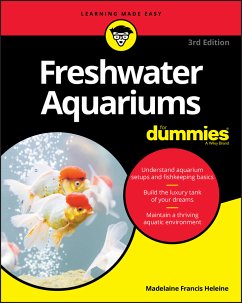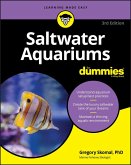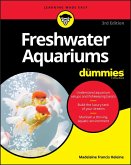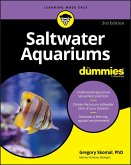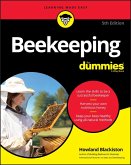Freshwater Aquariums For Dummies (eBook, PDF)


Alle Infos zum eBook verschenken

Freshwater Aquariums For Dummies (eBook, PDF)
- Format: PDF
- Merkliste
- Auf die Merkliste
- Bewerten Bewerten
- Teilen
- Produkt teilen
- Produkterinnerung
- Produkterinnerung

Hier können Sie sich einloggen

Bitte loggen Sie sich zunächst in Ihr Kundenkonto ein oder registrieren Sie sich bei bücher.de, um das eBook-Abo tolino select nutzen zu können.
Give your underwater pets the best aquatic life ever! Aquarium fish are one of the most popular pets in America, with close to 150 million fish owned in nearly 13 million households. They seem like easy pets to care for, but there's more than meets the eye when it comes to keeping your freshwater friends healthy and happy! Inside, you'll find basic information to start your own freshwater aquarium, purchase and maintain healthy fish and plants, and find tips and tricks on how to introduce new fish and systems into your aquatic family. * Understand the best aquarium set-up practices * Build the…mehr
- Geräte: PC
- mit Kopierschutz
- eBook Hilfe
- Größe: 26.75MB
![Saltwater Aquariums For Dummies (eBook, PDF) Saltwater Aquariums For Dummies (eBook, PDF)]() Gregory SkomalSaltwater Aquariums For Dummies (eBook, PDF)20,99 €
Gregory SkomalSaltwater Aquariums For Dummies (eBook, PDF)20,99 €![Freshwater Aquariums For Dummies (eBook, ePUB) Freshwater Aquariums For Dummies (eBook, ePUB)]() Madelaine Francis HeleineFreshwater Aquariums For Dummies (eBook, ePUB)19,99 €
Madelaine Francis HeleineFreshwater Aquariums For Dummies (eBook, ePUB)19,99 €![Saltwater Aquariums For Dummies (eBook, ePUB) Saltwater Aquariums For Dummies (eBook, ePUB)]() Gregory SkomalSaltwater Aquariums For Dummies (eBook, ePUB)20,99 €
Gregory SkomalSaltwater Aquariums For Dummies (eBook, ePUB)20,99 €![Beekeeping For Dummies (eBook, PDF) Beekeeping For Dummies (eBook, PDF)]() Howland BlackistonBeekeeping For Dummies (eBook, PDF)17,99 €
Howland BlackistonBeekeeping For Dummies (eBook, PDF)17,99 €![Chicken Health For Dummies (eBook, PDF) Chicken Health For Dummies (eBook, PDF)]() Julie GauthierChicken Health For Dummies (eBook, PDF)14,99 €
Julie GauthierChicken Health For Dummies (eBook, PDF)14,99 €![Koi For Dummies (eBook, PDF) Koi For Dummies (eBook, PDF)]() R. D. BartlettKoi For Dummies (eBook, PDF)13,99 €
R. D. BartlettKoi For Dummies (eBook, PDF)13,99 €![Rabbits For Dummies (eBook, PDF) Rabbits For Dummies (eBook, PDF)]() Connie IsbellRabbits For Dummies (eBook, PDF)19,99 €
Connie IsbellRabbits For Dummies (eBook, PDF)19,99 €-
-
-
Dieser Download kann aus rechtlichen Gründen nur mit Rechnungsadresse in A, B, BG, CY, CZ, D, DK, EW, E, FIN, F, GR, HR, H, IRL, I, LT, L, LR, M, NL, PL, P, R, S, SLO, SK ausgeliefert werden.
Hinweis: Dieser Artikel kann nur an eine deutsche Lieferadresse ausgeliefert werden.
- Produktdetails
- Verlag: John Wiley & Sons
- Seitenzahl: 400
- Erscheinungstermin: 10. September 2019
- Englisch
- ISBN-13: 9781119601401
- Artikelnr.: 57785963
- Verlag: John Wiley & Sons
- Seitenzahl: 400
- Erscheinungstermin: 10. September 2019
- Englisch
- ISBN-13: 9781119601401
- Artikelnr.: 57785963
- Herstellerkennzeichnung Die Herstellerinformationen sind derzeit nicht verfügbar.
About This Book 1
Foolish Assumptions 2
Icons Used in This Book 3
Where to Go from Here 4
Part 1: Getting Started with Freshwater Aquarium Basics 5
Chapter 1: Taking the Plunge: Just the Essentials 7
Focusing on the Tank, Stand, Accessories, and Equipment 8
Knowing where to put your tank 8
Looking at the tank and stand options 9
Figuring out what (besides fish) to put in your aquarium 9
Considering aquarium equipment 9
Determining what you really need 10
Caring for Your New Aquatic Pets 10
Eyeing differences in species 10
Assessing which types of fish are best for you 10
Buying fish - what you need to know 11
Feeding your fish - what types of food to buy 11
Taking care of sick fish 12
Understanding Water, Chemicals, and Live Plants 12
Grasping everything water 12
Using chemicals to improve your aquarium conditions 12
Testing your water 13
Getting a system going 13
Adding live plants 13
Fixing common problems 13
Expanding Your Aquarium Hobby 13
Breeding your fish: Yes or no? 13
Keeping track of your progress 14
Broadening your hobby 14
Contemplating other types of aquarium structures 14
Chapter 2: The Practice of Aquarium Keeping 15
Recognizing the Amazing Benefits of Owning an Aquarium 16
Identifying Aquarium Water Systems 18
Freshwater systems 19
Saltwater systems 21
Brackish systems 22
Organization Is the Key to Success 23
Chapter 3: Finding a Good Location 25
Making Sure Your Floor Is Sound 26
Taking Room Temperature and Its Effects into Consideration 26
Wicked windows 27
Deadly doors 28
High Traffic Areas, Children, and Pets (Spell D-I-S-A-S-T-E-R) 28
Contemplating Your Water Source When Placing Your Aquarium 30
Thinking about Other Household Items 30
Furniture and space 30
Electrical outlets and TVs 31
Overhead lighting 32
Cleaning considerations 32
Chapter 4: The Tank and Stand 33
Buying a Tank: What You Need to Know 33
Water is heavy 34
Watching the tendency to overspend 35
Checking out starter kits 35
Size matters - gauging space requirements 36
Taking people into consideration 37
Deciding where to buy 38
Examining the Different Types of Aquariums Available 39
Glass aquariums 40
Acrylic aquariums 41
Plastic aquariums (bowls and small tanks) 42
Rimless tanks 42
Considering Different and Unusual Aquarium Styles 43
Wall-mounted aquariums 43
In-wall tanks 43
Furniture aquariums 44
Tower aquariums 44
Indoor pond barrels 45
All-in-one tanks 45
Betta tanks and water gardens 45
Special tanks from the pros 45
Choosing the Right Tank 46
Tank size 46
Tank shape 47
Carrying capacity 47
Picking the Right Stand 47
Wooden cabinet stands 48
Angle and wrought iron stands 48
Aluminum stands 49
Do-it-yourself stands 49
Material-based stands 49
Bow-front stands 49
Moving an Aquarium 50
Chapter 5: Aquascaping Your Aquarium: What to Add and Not Add in Your Tank
51
Taking Clues from Your Fish's Natural Environment 52
Getting the Lowdown on Substrates 53
Starting with the basics: Gravel, aqua soil, and fluorite 54
Thinking about pH with your substrates 54
Knowing which substrates to avoid 55
Being aware of gravel size and the perils of sand 56
Adding new substrate to your system 56
Using established substrate 57
Considering Rocks, Wood, and Artificial Plants 57
Rocks for freshwater tanks 58
Wood for a freshwater tank 58
Plastic plants 60
Contemplating Other Aquarium Decorations 62
Keeping safety first 62
Eyeing plastic divers and other oddities 62
Aquascaping Tips and Tricks 63
Chapter 6: Selecting the Equipment and Other Stuff Your Aquarium Needs 67
Taking the Mystery out of Filters 68
Mechanical filtration 69
Biological filtration 69
Chemical filtration 70
Sifting through Filtration Systems 70
Undergravel filters 71
Sponge filters 71
Corner filters 72
Power filters 72
Canister filters 73
Fluidized bed filters 74
Diatom filters 74
Wet/dry filters 75
Natural filtration with plants 75
An underground filter's best friend - powerheads 76
Gauging Heaters and Thermometers 77
Submersible heaters 77
Nonsubmersible heaters 77
Digital heaters 77
Heating your aquarium: Thermometers 78
Making Bubbles with Airstones and Pumps 79
Air pumps 79
Airstones and other bubble makers 80
Connecting Tubing, Valves, and Tees 81
Air-line tubing 81
Gang valves and tees 82
Creating the Best Lighting 83
Looking at bulb types 84
Making a hood choice 85
Part 2: Taking a Closer Look at Fish and How to Care for Them 87
Chapter 7: Fish Anatomy 101 89
Understanding What Makes a Fish Go 90
The dorsal fin 90
The caudal fin 91
The anal fin 91
The pectoral fins 92
The pelvic fins 92
The adipose fin 92
Swimming movement 92
Breathing In and Out - Respiration 93
The gill method 93
The labyrinth organ method 94
Getting Acquainted with the Senses 95
Sight 95
Hearing 97
Smelling 97
Tasting 97
Feeling 98
Comprehending Osmosis and the Salt-to-Water Ratio 98
Fish that don't drink water 99
Fish that need to drink water 99
Recognizing Traits to Identify Fish 99
Body shape 100
Taxonomy 100
The swim bladder 102
Color and its purpose 102
Chapter 8: Figuring Out What Kind of Fish to Buy 105
Looking Closer at Freshwater Fish 106
Anabantids 106
Cyprinodonts and livebearers 108
Catfish (plecos, cories, and one special Cypriniforme) 112
Characins 114
Unusual characins 117
Loaches 119
African cichlids 120
American cichlids 121
Cyprinids 125
Freshwater tropical invertebrates 127
Contemplating Coldwater Fish and Invertebrates 129
Koi (Cyprinus carpio) 129
Goldfish (Carassius auratus) 129
White cloud mountain minnows (Tanichthys albonubes) 132
Coldwater invertebrates 132
Thinking about Captive-Bred Species 134
Buying Fish Online 135
Chapter 9: Working with a Fish Dealer to Purchase Your Fish 137
Choosing a Quality Fish Dealer 138
Searching for a fish store 138
The importance of great service 140
The store's appearance 140
Dealer Practices: The Good, the Bad, and the Ugly 142
Do Bee dealers 143
Don't Bee dealers 143
Wanna Bee dealers 144
Developing a Good Relationship with Your Fish Dealer 145
Selecting Healthy Fish 145
Start simply and do your homework 145
Look for signs of good health 146
Know your fish's behavior 146
Understand how big the fish will grow 147
Avoid the first fish off the boat 148
Don't be Doctor Doolittle 148
Getting the Right Fish without Going Overboard 149
Chapter 10: Feeding Your Wet Pets - Diet and Nutrition 151
Understanding Basic Nutrition 151
Recognizing what your fish need 152
Being aware of overfeeding 153
Underfeeding is just as bad 153
Feeding just what your fish need 153
Knowing What Type of Eater You Have 155
Taking action when they stop eating 155
Meeting your carnivores' desires 156
Going leafy and feeding vegetarians 156
Feeding fish that eat anything that falls into the tank 157
Identifying the Different Types of Food 157
Prepackaged foods 157
Frozen foods 158
Freeze-dried foods 158
Spirulina 159
Live food - the stuff they really love and want 159
Brine shrimp 160
Infusoria 161
Rotifers 161
Tubifex, bloodworms, mosquito larvae, and earthworms (yuck!) 161
Feeding Fry 162
Microworms 162
Liquid, powdered, and growth foods 162
Chapter 11: Recognizing Diseases and Treatments 163
An Ounce of Prevention 163
Your daily review 164
Your weekly to-do list 165
Monthly checklist 168
Identifying Common Ailments and Cures 168
Common bacterial infection 169
Constipation 169
Dropsy 169
Fin rot 169
Fish louse 170
Freshwater velvet 170
Freshwater ich 170
Fungus 171
Gill parasites 171
Hole in the head 171
Intestinal parasites 172
Large skin parasites 172
Mouth fungus 172
Pop-eye 172
Septicemia 173
Skin flukes 173
Slimy skin disease 173
Swim bladder disease 174
Tuberculosis (TB) 174
Keeping an Eye Open for Frequent Causes of Disease 174
Carbon dioxide poisoning 175
Poor water quality 175
Metal poisoning 175
Chemical poisoning 175
Improper diet 176
Overfeeding 176
Frightened fish 176
Relying on a Tried-and-True Home Remedy: Giving a Salt Bath 177
Playing Detective: The Sherlock Holmes Method 177
Using Quarantine Tanks 178
Grasping the purpose and advantages of quarantining 178
Knowing how much time to quarantine 179
Keeping good records: Writing it all down 179
Focusing on the tank 179
Setting Up a Hospital Tank 180
Understanding Medications 180
Part 3: The Background Players: Water, Chemicals, and Plants 183
Chapter 12: All Water Isn't Created Equal 185
Comparing Different Water Types 186
Tap water 186
Rainwater 188
The advantages of bottled water (not Perrier) 189
Well water (don't count on it) 189
Collecting Water from Bodies of Water (Why You Want to Forget This Bad
Idea) 190
Adding Water to Your Aquarium 190
Using a garden hose 190
Using a Python 191
Moving water the old-fashioned way 191
Chapter 13: Considering Those Crazy Chemicals 193
Understanding Chemical Use 194
Knowing when to use (and not use) chemicals 194
Following instructions to the letter 194
Knowing Which Chemicals You Need to Start Your Aquarium 195
Glass cleaner 195
Dechlorinator 195
Water conditioner 196
Cycling chemicals 196
Bacteria in a bottle 197
Bacteria on a medium 197
Maintaining Your Aquarium: Chemicals to Use 197
Using the Right Chemicals for Your Plants 198
Create your own rainforest 198
Plant growth 199
Root tabs 199
Algae control 199
Naming Chemicals Your Fish Need for Medication 200
Chapter 14: The Nitrogen Cycle and Water Testing 201
Eliminating Fish Waste 201
Conditioning Your Tank 202
Starting the Nitrogen Cycle 203
Encouraging nitrosamonas (good bacteria number one) 203
Promoting nitrobacter (good bacteria number two) 205
Monitoring through the conditioning period 205
Speeding things up a bit 206
Preventing new tank syndrome 207
Testing Ammonia, Nitrites, Nitrates, and pH 207
Changing the water regularly 207
Maintaining proper pH levels 208
Testing Hardness (dH) 210
Chapter 15: Putting It All Together 211
Setting Up Your Tropical Freshwater System 212
Setting Up a Small Plant Tank 214
Setting Up Your Coldwater System 215
Setting Up Your Simple Indoor Goldfish Pond 216
Chapter 16: What You Need to Know: Live Plants for Aquariums 217
Understanding What Live Plants Do for Your Aquarium 218
Identifying Different Plant Types 220
Ferns and mosses 221
Floating plants 221
Stem plants 221
Rooted plants 221
Cuttings 222
Maintaining Plant-Friendly Aquarium Conditions 222
Temperature requirements 222
Substrate for rooting 223
Filtration 223
Feeding 223
Lighting 224
Other supplements 224
Purchasing and Transporting Your Plants 224
Taking from the wild 224
Buying from a dealer 225
Buying online 225
Getting plants home in one piece 226
Achieving acclimation 226
Noticing Potential Plant Problems 227
Recognizing signs of poor plant health and what to do about them 227
Algae 228
Medications 228
Planting Techniques and Aquascaping 229
Chapter 17: Choosing Plant Species for Your Tank 231
Considering Foreground Plants 232
Baby tears (Micranthemum umbrosum) 232
Brazilian micro sword (Lilaeopsis brasiliensis) 233
Cryptocoryne (Cryptocoryne wendetti) 233
Dwarf anubias (Anubias nana) 234
Dwarf four-leaf clover (Marsilia hirsute) 234
Java moss (Taxiphyllum barbieri) 235
Madagascar lace (Aponogeton fenestralis) 235
Pearl grass (Hemianthus micranthemoides) 236
Looking at Midwater Plants 237
Aquatic banana plant (Nymphoides aquatica) 237
Coffeefolia (Anusbis barteri) 237
Dwarf sagittaria (Sagittaria subulata) 237
Water wisteria (Hygrophila difformis) 238
Contemplating Background Plants 238
Amazon sword (Echinodorus amazonicus) 238
Carolina fanwort (Cambomba caroliniana) 239
Corkscrew val (Vallisneria spiralis) 239
Elodea (Egeria densa) 240
Giant anubias (Anubias barteri) 241
Hornwort (Ceratophyllum demersum) 241
Oriental sword (Echinodorus oriental) 242
Red ludwigia (Ludwigia mullertii) 243
Red-stem milfoil (Myriophyllum matogrossensis) 244
Stargrass (Heteranthera zosterifolia) 244
Going with Floating Plants 244
Amazon frogbit (Limnobium laevigatum) 245
Duckweed (Lemna minor) 245
Envisioning Pond Plants 245
Water hyacinth (Eichhornia crassipes) 246
Water lettuce (Pistia stratiotes) 246
Starting with Some Easy Plants 247
Part 4: Breeding and Other Fun Stuff 249
Chapter 18: Being Prepared When Trouble Strikes 251
Tackling Physical Fish Problems 252
Separating fighting fish 252
Solving the aggression problem 252
Looking at the injured 253
Dealing with a stuck fish 253
Correcting Feeding Problems 253
Getting your fish to eat 253
Addressing a food hog 253
Dislodging items eaten by your fish 254
Cleaning up the aftermath 254
Addressing Equipment Problems 254
Handling uneven stands and tanks 254
Fixing a clogged filter 254
Analyzing heater problems 254
Lighting falling into the tank 255
Exploding light bulbs 255
Flickering lighting 255
Facing Tank and Decoration Problems 256
Checking for leaks 256
Getting your fish to safety 256
Repairing a small crack 256
When an entire side of your aquarium breaks 257
Uprooted plants and decorations 257
What to do when you lose power 257
Confronting Water Problems 257
Solving green algae problems 258
Controlling chemical problems 258
Cooling a tank that's too hot 258
Warming a tank that's too cold 259
Chapter 19: Setting Up the Breeding Tank 261
Deciding to Breed Your Aquarium Fish 262
Breaking new barriers 262
Gaining new knowledge and enjoyment 263
Conserving the environment 263
Choosing Your Equipment for Breeding 263
The aquarium 264
Putting a lid on the whole thing 264
Decorations 264
Substrate 265
Spawning grates 265
Turning up the heat 266
Filtration 266
Plants for safety, spawning, and inspiration 267
Getting the Water Right 269
pH and dH control 269
Water temperature 269
Cleanliness 269
Chapter 20: Ready, Set, Spawn 271
Introducing the Bride and Groom 272
Dealing with aggressive males 274
Setting up the second date 274
Yay, my fish really like each other! 274
Darn, my fish hate each other! 274
Understanding Breeding Types 277
Livebearers 277
The egglayers 277
Saving Everyone from Everyone Else 279
Saving Mom and Dad from Mom and Dad 279
Saving the kids from Mom and Dad 280
Saving the kids from each other 281
Raising the Fry 281
Stepping up to brine shrimp 282
Giving them a real home 282
Picking new stock 282
Understanding Genetics 282
Choosing the best 283
Obtaining variation the good way 283
Obtaining variation through mutation 283
Creating strains through inbreeding 283
Choosing the Right Species for You 284
Breeding livebearers 284
Other fun fish to breed 285
Chapter 21: Recording Data and Photographing Fish 289
Keeping a Logbook 289
Making Your Fish the Stars They Were Meant to Be 290
Knowing Where to Take Pictures 291
Photographing Your Fish with Digital Photography 292
Recording fish 293
Printing your work 293
Sharing your work online 294
Photographing Your Fish the Old-Fashioned Way 294
Film cameras 294
The film 295
Lenses 296
Considering Lighting 297
Relying on lighting 297
Making your fish shine 299
Focusing Your Camera 300
Understanding Composition Techniques 300
Using the rule of thirds 301
Panning the scene 301
Setting up for close-ups 302
Shooting the Tank 302
Building your own photography tank 303
Using different backgrounds 304
Chapter 22: Expanding Your Hobby in Fun Ways 305
Entering a Fish Show 305
Getting to Know the Types of Shows 307
Participating in exhibitions 307
Understanding competition classes 307
Preparing Your Fish for the Show 308
The holding tank 308
Water conditions 309
Tank considerations 309
Knowing what the judges are looking for 310
Transporting Fish to and from a Show 312
Remembering to Have Fun 313
Joining an Aquarium Club 314
Volunteering at an Aquarium or Zoo 314
Writing an Article 315
Setting Up a Tank for a Worthy Cause 316
Sharing Your Love of Aquariums and Science with Others 317
Chapter 23: Advancing Your Hobby: Other Types of Aquarium Systems 319
Trying a Brackish Aquarium Setup 319
Considering a Marine Aquarium System 320
Identifying the types of marine systems 321
Setting up a simple marine aquarium 322
Setting up a coldwater fish-only marine system 323
Comparing Freshwater and Saltwater Systems 324
Adaptability 324
Availability 325
Cost 325
Beauty and friendliness 325
Equipment 326
Part 5: The Part of Tens 327
Chapter 24: Ten Cool Aquarium Gadgets 329
Aquarium Claws (Those Handy Picker-Upper Doodads) to Move Decor 329
Algae Cleaners to Keep Dry 330
Extendable Fish Nets, the Long and Short of It 331
A Tool Box for Storing Stuff 331
Light Timers for the Win 332
Aquarium Sealer (Flood Insurance) 332
Aquascaping Tools to Make You a Star 332
Digital Water Testing Makes It Easy 333
Automatic Gravel Cleaners Do the Job 333
Aquarium Smart Controllers (Spy on Your Fish) 334
Chapter 25: Ten Ways to Kill Your Fish without Even Trying 335
Go Away on Vacation and Forget Them 335
Play Doctor without a License 336
Give Your Cat a Sushi Bar 336
Stuff Your Fish with Seven-Course Meals 337
Mix Apples and Oranges 337
Add Too Many Fish (the Shoehorn Syndrome) 338
Don't Do Your Homework 338
Let the Neighbor's Unruly Kid Play with Your Fish 338
Become a Hypochondriac Hobbyist 339
Buy Used or Cheap Equipment 339
Chapter 26: Ten Scientific Fish Laws 341
The Fish Law of Thermodynamics 341
The Fish Law of Metamorphosis 342
The Fish Law of Motion 342
The Fish Law of Anti-Matter 343
The Fish Law of Nutrition 343
The Fish Law of Company 344
The Fish Law of Potential Energy 344
The Fish Law of Psychic Felines 344
The Fish Law of Aggression 345
The Fish Law of Time 345
Chapter 27: Ten Aquatic New Year's Resolutions 347
Feed the Fish the Good Stuff 347
Clean the Tank Frequently 348
Reduce Celibacy 348
Remove Algae 348
Monitor Filter Mediums 348
Turn on the Lights 349
Use My Test Kits 349
Pay Attention to My Fish 349
Redecorate the Tank 349
Share with Others 350
Index 351
About This Book 1
Foolish Assumptions 2
Icons Used in This Book 3
Where to Go from Here 4
Part 1: Getting Started with Freshwater Aquarium Basics 5
Chapter 1: Taking the Plunge: Just the Essentials 7
Focusing on the Tank, Stand, Accessories, and Equipment 8
Knowing where to put your tank 8
Looking at the tank and stand options 9
Figuring out what (besides fish) to put in your aquarium 9
Considering aquarium equipment 9
Determining what you really need 10
Caring for Your New Aquatic Pets 10
Eyeing differences in species 10
Assessing which types of fish are best for you 10
Buying fish - what you need to know 11
Feeding your fish - what types of food to buy 11
Taking care of sick fish 12
Understanding Water, Chemicals, and Live Plants 12
Grasping everything water 12
Using chemicals to improve your aquarium conditions 12
Testing your water 13
Getting a system going 13
Adding live plants 13
Fixing common problems 13
Expanding Your Aquarium Hobby 13
Breeding your fish: Yes or no? 13
Keeping track of your progress 14
Broadening your hobby 14
Contemplating other types of aquarium structures 14
Chapter 2: The Practice of Aquarium Keeping 15
Recognizing the Amazing Benefits of Owning an Aquarium 16
Identifying Aquarium Water Systems 18
Freshwater systems 19
Saltwater systems 21
Brackish systems 22
Organization Is the Key to Success 23
Chapter 3: Finding a Good Location 25
Making Sure Your Floor Is Sound 26
Taking Room Temperature and Its Effects into Consideration 26
Wicked windows 27
Deadly doors 28
High Traffic Areas, Children, and Pets (Spell D-I-S-A-S-T-E-R) 28
Contemplating Your Water Source When Placing Your Aquarium 30
Thinking about Other Household Items 30
Furniture and space 30
Electrical outlets and TVs 31
Overhead lighting 32
Cleaning considerations 32
Chapter 4: The Tank and Stand 33
Buying a Tank: What You Need to Know 33
Water is heavy 34
Watching the tendency to overspend 35
Checking out starter kits 35
Size matters - gauging space requirements 36
Taking people into consideration 37
Deciding where to buy 38
Examining the Different Types of Aquariums Available 39
Glass aquariums 40
Acrylic aquariums 41
Plastic aquariums (bowls and small tanks) 42
Rimless tanks 42
Considering Different and Unusual Aquarium Styles 43
Wall-mounted aquariums 43
In-wall tanks 43
Furniture aquariums 44
Tower aquariums 44
Indoor pond barrels 45
All-in-one tanks 45
Betta tanks and water gardens 45
Special tanks from the pros 45
Choosing the Right Tank 46
Tank size 46
Tank shape 47
Carrying capacity 47
Picking the Right Stand 47
Wooden cabinet stands 48
Angle and wrought iron stands 48
Aluminum stands 49
Do-it-yourself stands 49
Material-based stands 49
Bow-front stands 49
Moving an Aquarium 50
Chapter 5: Aquascaping Your Aquarium: What to Add and Not Add in Your Tank
51
Taking Clues from Your Fish's Natural Environment 52
Getting the Lowdown on Substrates 53
Starting with the basics: Gravel, aqua soil, and fluorite 54
Thinking about pH with your substrates 54
Knowing which substrates to avoid 55
Being aware of gravel size and the perils of sand 56
Adding new substrate to your system 56
Using established substrate 57
Considering Rocks, Wood, and Artificial Plants 57
Rocks for freshwater tanks 58
Wood for a freshwater tank 58
Plastic plants 60
Contemplating Other Aquarium Decorations 62
Keeping safety first 62
Eyeing plastic divers and other oddities 62
Aquascaping Tips and Tricks 63
Chapter 6: Selecting the Equipment and Other Stuff Your Aquarium Needs 67
Taking the Mystery out of Filters 68
Mechanical filtration 69
Biological filtration 69
Chemical filtration 70
Sifting through Filtration Systems 70
Undergravel filters 71
Sponge filters 71
Corner filters 72
Power filters 72
Canister filters 73
Fluidized bed filters 74
Diatom filters 74
Wet/dry filters 75
Natural filtration with plants 75
An underground filter's best friend - powerheads 76
Gauging Heaters and Thermometers 77
Submersible heaters 77
Nonsubmersible heaters 77
Digital heaters 77
Heating your aquarium: Thermometers 78
Making Bubbles with Airstones and Pumps 79
Air pumps 79
Airstones and other bubble makers 80
Connecting Tubing, Valves, and Tees 81
Air-line tubing 81
Gang valves and tees 82
Creating the Best Lighting 83
Looking at bulb types 84
Making a hood choice 85
Part 2: Taking a Closer Look at Fish and How to Care for Them 87
Chapter 7: Fish Anatomy 101 89
Understanding What Makes a Fish Go 90
The dorsal fin 90
The caudal fin 91
The anal fin 91
The pectoral fins 92
The pelvic fins 92
The adipose fin 92
Swimming movement 92
Breathing In and Out - Respiration 93
The gill method 93
The labyrinth organ method 94
Getting Acquainted with the Senses 95
Sight 95
Hearing 97
Smelling 97
Tasting 97
Feeling 98
Comprehending Osmosis and the Salt-to-Water Ratio 98
Fish that don't drink water 99
Fish that need to drink water 99
Recognizing Traits to Identify Fish 99
Body shape 100
Taxonomy 100
The swim bladder 102
Color and its purpose 102
Chapter 8: Figuring Out What Kind of Fish to Buy 105
Looking Closer at Freshwater Fish 106
Anabantids 106
Cyprinodonts and livebearers 108
Catfish (plecos, cories, and one special Cypriniforme) 112
Characins 114
Unusual characins 117
Loaches 119
African cichlids 120
American cichlids 121
Cyprinids 125
Freshwater tropical invertebrates 127
Contemplating Coldwater Fish and Invertebrates 129
Koi (Cyprinus carpio) 129
Goldfish (Carassius auratus) 129
White cloud mountain minnows (Tanichthys albonubes) 132
Coldwater invertebrates 132
Thinking about Captive-Bred Species 134
Buying Fish Online 135
Chapter 9: Working with a Fish Dealer to Purchase Your Fish 137
Choosing a Quality Fish Dealer 138
Searching for a fish store 138
The importance of great service 140
The store's appearance 140
Dealer Practices: The Good, the Bad, and the Ugly 142
Do Bee dealers 143
Don't Bee dealers 143
Wanna Bee dealers 144
Developing a Good Relationship with Your Fish Dealer 145
Selecting Healthy Fish 145
Start simply and do your homework 145
Look for signs of good health 146
Know your fish's behavior 146
Understand how big the fish will grow 147
Avoid the first fish off the boat 148
Don't be Doctor Doolittle 148
Getting the Right Fish without Going Overboard 149
Chapter 10: Feeding Your Wet Pets - Diet and Nutrition 151
Understanding Basic Nutrition 151
Recognizing what your fish need 152
Being aware of overfeeding 153
Underfeeding is just as bad 153
Feeding just what your fish need 153
Knowing What Type of Eater You Have 155
Taking action when they stop eating 155
Meeting your carnivores' desires 156
Going leafy and feeding vegetarians 156
Feeding fish that eat anything that falls into the tank 157
Identifying the Different Types of Food 157
Prepackaged foods 157
Frozen foods 158
Freeze-dried foods 158
Spirulina 159
Live food - the stuff they really love and want 159
Brine shrimp 160
Infusoria 161
Rotifers 161
Tubifex, bloodworms, mosquito larvae, and earthworms (yuck!) 161
Feeding Fry 162
Microworms 162
Liquid, powdered, and growth foods 162
Chapter 11: Recognizing Diseases and Treatments 163
An Ounce of Prevention 163
Your daily review 164
Your weekly to-do list 165
Monthly checklist 168
Identifying Common Ailments and Cures 168
Common bacterial infection 169
Constipation 169
Dropsy 169
Fin rot 169
Fish louse 170
Freshwater velvet 170
Freshwater ich 170
Fungus 171
Gill parasites 171
Hole in the head 171
Intestinal parasites 172
Large skin parasites 172
Mouth fungus 172
Pop-eye 172
Septicemia 173
Skin flukes 173
Slimy skin disease 173
Swim bladder disease 174
Tuberculosis (TB) 174
Keeping an Eye Open for Frequent Causes of Disease 174
Carbon dioxide poisoning 175
Poor water quality 175
Metal poisoning 175
Chemical poisoning 175
Improper diet 176
Overfeeding 176
Frightened fish 176
Relying on a Tried-and-True Home Remedy: Giving a Salt Bath 177
Playing Detective: The Sherlock Holmes Method 177
Using Quarantine Tanks 178
Grasping the purpose and advantages of quarantining 178
Knowing how much time to quarantine 179
Keeping good records: Writing it all down 179
Focusing on the tank 179
Setting Up a Hospital Tank 180
Understanding Medications 180
Part 3: The Background Players: Water, Chemicals, and Plants 183
Chapter 12: All Water Isn't Created Equal 185
Comparing Different Water Types 186
Tap water 186
Rainwater 188
The advantages of bottled water (not Perrier) 189
Well water (don't count on it) 189
Collecting Water from Bodies of Water (Why You Want to Forget This Bad
Idea) 190
Adding Water to Your Aquarium 190
Using a garden hose 190
Using a Python 191
Moving water the old-fashioned way 191
Chapter 13: Considering Those Crazy Chemicals 193
Understanding Chemical Use 194
Knowing when to use (and not use) chemicals 194
Following instructions to the letter 194
Knowing Which Chemicals You Need to Start Your Aquarium 195
Glass cleaner 195
Dechlorinator 195
Water conditioner 196
Cycling chemicals 196
Bacteria in a bottle 197
Bacteria on a medium 197
Maintaining Your Aquarium: Chemicals to Use 197
Using the Right Chemicals for Your Plants 198
Create your own rainforest 198
Plant growth 199
Root tabs 199
Algae control 199
Naming Chemicals Your Fish Need for Medication 200
Chapter 14: The Nitrogen Cycle and Water Testing 201
Eliminating Fish Waste 201
Conditioning Your Tank 202
Starting the Nitrogen Cycle 203
Encouraging nitrosamonas (good bacteria number one) 203
Promoting nitrobacter (good bacteria number two) 205
Monitoring through the conditioning period 205
Speeding things up a bit 206
Preventing new tank syndrome 207
Testing Ammonia, Nitrites, Nitrates, and pH 207
Changing the water regularly 207
Maintaining proper pH levels 208
Testing Hardness (dH) 210
Chapter 15: Putting It All Together 211
Setting Up Your Tropical Freshwater System 212
Setting Up a Small Plant Tank 214
Setting Up Your Coldwater System 215
Setting Up Your Simple Indoor Goldfish Pond 216
Chapter 16: What You Need to Know: Live Plants for Aquariums 217
Understanding What Live Plants Do for Your Aquarium 218
Identifying Different Plant Types 220
Ferns and mosses 221
Floating plants 221
Stem plants 221
Rooted plants 221
Cuttings 222
Maintaining Plant-Friendly Aquarium Conditions 222
Temperature requirements 222
Substrate for rooting 223
Filtration 223
Feeding 223
Lighting 224
Other supplements 224
Purchasing and Transporting Your Plants 224
Taking from the wild 224
Buying from a dealer 225
Buying online 225
Getting plants home in one piece 226
Achieving acclimation 226
Noticing Potential Plant Problems 227
Recognizing signs of poor plant health and what to do about them 227
Algae 228
Medications 228
Planting Techniques and Aquascaping 229
Chapter 17: Choosing Plant Species for Your Tank 231
Considering Foreground Plants 232
Baby tears (Micranthemum umbrosum) 232
Brazilian micro sword (Lilaeopsis brasiliensis) 233
Cryptocoryne (Cryptocoryne wendetti) 233
Dwarf anubias (Anubias nana) 234
Dwarf four-leaf clover (Marsilia hirsute) 234
Java moss (Taxiphyllum barbieri) 235
Madagascar lace (Aponogeton fenestralis) 235
Pearl grass (Hemianthus micranthemoides) 236
Looking at Midwater Plants 237
Aquatic banana plant (Nymphoides aquatica) 237
Coffeefolia (Anusbis barteri) 237
Dwarf sagittaria (Sagittaria subulata) 237
Water wisteria (Hygrophila difformis) 238
Contemplating Background Plants 238
Amazon sword (Echinodorus amazonicus) 238
Carolina fanwort (Cambomba caroliniana) 239
Corkscrew val (Vallisneria spiralis) 239
Elodea (Egeria densa) 240
Giant anubias (Anubias barteri) 241
Hornwort (Ceratophyllum demersum) 241
Oriental sword (Echinodorus oriental) 242
Red ludwigia (Ludwigia mullertii) 243
Red-stem milfoil (Myriophyllum matogrossensis) 244
Stargrass (Heteranthera zosterifolia) 244
Going with Floating Plants 244
Amazon frogbit (Limnobium laevigatum) 245
Duckweed (Lemna minor) 245
Envisioning Pond Plants 245
Water hyacinth (Eichhornia crassipes) 246
Water lettuce (Pistia stratiotes) 246
Starting with Some Easy Plants 247
Part 4: Breeding and Other Fun Stuff 249
Chapter 18: Being Prepared When Trouble Strikes 251
Tackling Physical Fish Problems 252
Separating fighting fish 252
Solving the aggression problem 252
Looking at the injured 253
Dealing with a stuck fish 253
Correcting Feeding Problems 253
Getting your fish to eat 253
Addressing a food hog 253
Dislodging items eaten by your fish 254
Cleaning up the aftermath 254
Addressing Equipment Problems 254
Handling uneven stands and tanks 254
Fixing a clogged filter 254
Analyzing heater problems 254
Lighting falling into the tank 255
Exploding light bulbs 255
Flickering lighting 255
Facing Tank and Decoration Problems 256
Checking for leaks 256
Getting your fish to safety 256
Repairing a small crack 256
When an entire side of your aquarium breaks 257
Uprooted plants and decorations 257
What to do when you lose power 257
Confronting Water Problems 257
Solving green algae problems 258
Controlling chemical problems 258
Cooling a tank that's too hot 258
Warming a tank that's too cold 259
Chapter 19: Setting Up the Breeding Tank 261
Deciding to Breed Your Aquarium Fish 262
Breaking new barriers 262
Gaining new knowledge and enjoyment 263
Conserving the environment 263
Choosing Your Equipment for Breeding 263
The aquarium 264
Putting a lid on the whole thing 264
Decorations 264
Substrate 265
Spawning grates 265
Turning up the heat 266
Filtration 266
Plants for safety, spawning, and inspiration 267
Getting the Water Right 269
pH and dH control 269
Water temperature 269
Cleanliness 269
Chapter 20: Ready, Set, Spawn 271
Introducing the Bride and Groom 272
Dealing with aggressive males 274
Setting up the second date 274
Yay, my fish really like each other! 274
Darn, my fish hate each other! 274
Understanding Breeding Types 277
Livebearers 277
The egglayers 277
Saving Everyone from Everyone Else 279
Saving Mom and Dad from Mom and Dad 279
Saving the kids from Mom and Dad 280
Saving the kids from each other 281
Raising the Fry 281
Stepping up to brine shrimp 282
Giving them a real home 282
Picking new stock 282
Understanding Genetics 282
Choosing the best 283
Obtaining variation the good way 283
Obtaining variation through mutation 283
Creating strains through inbreeding 283
Choosing the Right Species for You 284
Breeding livebearers 284
Other fun fish to breed 285
Chapter 21: Recording Data and Photographing Fish 289
Keeping a Logbook 289
Making Your Fish the Stars They Were Meant to Be 290
Knowing Where to Take Pictures 291
Photographing Your Fish with Digital Photography 292
Recording fish 293
Printing your work 293
Sharing your work online 294
Photographing Your Fish the Old-Fashioned Way 294
Film cameras 294
The film 295
Lenses 296
Considering Lighting 297
Relying on lighting 297
Making your fish shine 299
Focusing Your Camera 300
Understanding Composition Techniques 300
Using the rule of thirds 301
Panning the scene 301
Setting up for close-ups 302
Shooting the Tank 302
Building your own photography tank 303
Using different backgrounds 304
Chapter 22: Expanding Your Hobby in Fun Ways 305
Entering a Fish Show 305
Getting to Know the Types of Shows 307
Participating in exhibitions 307
Understanding competition classes 307
Preparing Your Fish for the Show 308
The holding tank 308
Water conditions 309
Tank considerations 309
Knowing what the judges are looking for 310
Transporting Fish to and from a Show 312
Remembering to Have Fun 313
Joining an Aquarium Club 314
Volunteering at an Aquarium or Zoo 314
Writing an Article 315
Setting Up a Tank for a Worthy Cause 316
Sharing Your Love of Aquariums and Science with Others 317
Chapter 23: Advancing Your Hobby: Other Types of Aquarium Systems 319
Trying a Brackish Aquarium Setup 319
Considering a Marine Aquarium System 320
Identifying the types of marine systems 321
Setting up a simple marine aquarium 322
Setting up a coldwater fish-only marine system 323
Comparing Freshwater and Saltwater Systems 324
Adaptability 324
Availability 325
Cost 325
Beauty and friendliness 325
Equipment 326
Part 5: The Part of Tens 327
Chapter 24: Ten Cool Aquarium Gadgets 329
Aquarium Claws (Those Handy Picker-Upper Doodads) to Move Decor 329
Algae Cleaners to Keep Dry 330
Extendable Fish Nets, the Long and Short of It 331
A Tool Box for Storing Stuff 331
Light Timers for the Win 332
Aquarium Sealer (Flood Insurance) 332
Aquascaping Tools to Make You a Star 332
Digital Water Testing Makes It Easy 333
Automatic Gravel Cleaners Do the Job 333
Aquarium Smart Controllers (Spy on Your Fish) 334
Chapter 25: Ten Ways to Kill Your Fish without Even Trying 335
Go Away on Vacation and Forget Them 335
Play Doctor without a License 336
Give Your Cat a Sushi Bar 336
Stuff Your Fish with Seven-Course Meals 337
Mix Apples and Oranges 337
Add Too Many Fish (the Shoehorn Syndrome) 338
Don't Do Your Homework 338
Let the Neighbor's Unruly Kid Play with Your Fish 338
Become a Hypochondriac Hobbyist 339
Buy Used or Cheap Equipment 339
Chapter 26: Ten Scientific Fish Laws 341
The Fish Law of Thermodynamics 341
The Fish Law of Metamorphosis 342
The Fish Law of Motion 342
The Fish Law of Anti-Matter 343
The Fish Law of Nutrition 343
The Fish Law of Company 344
The Fish Law of Potential Energy 344
The Fish Law of Psychic Felines 344
The Fish Law of Aggression 345
The Fish Law of Time 345
Chapter 27: Ten Aquatic New Year's Resolutions 347
Feed the Fish the Good Stuff 347
Clean the Tank Frequently 348
Reduce Celibacy 348
Remove Algae 348
Monitor Filter Mediums 348
Turn on the Lights 349
Use My Test Kits 349
Pay Attention to My Fish 349
Redecorate the Tank 349
Share with Others 350
Index 351
